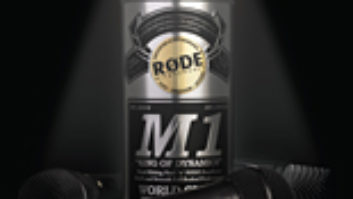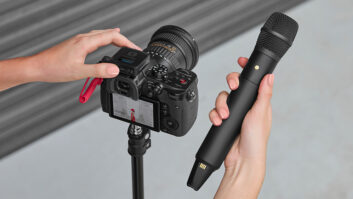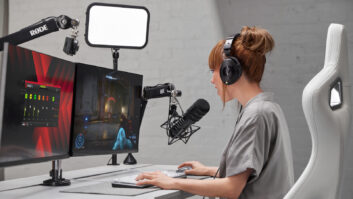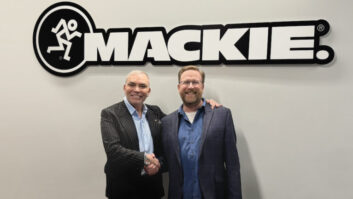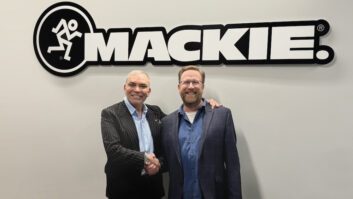Anyone who lurks the newsgroups on the Internet knows that I’m
highly opinionated when it comes to audio. And, in the years since
I reviewed the RØDE Classic mic, the company’s president,
Peter Freedman, and I have occasionally exchanged e-mails
concerning various audio topics. Microphone self-noise and
mic-to-mic consistency were frequent topics during those
conversations.
After Neumann debuted its TLM103, I remember telling Peter that,
not only did the TLM103 have the lowest self-noise I had ever heard
(7 dBA), but it also had about a 6dB higher output (sensitivity)
than most other mics at that time. Low self-noise is appreciated by
those who record digitally, especially if the sound sources are
quiet. A mic with higher sensitivity further reduces the audible
self-noise of a mic relative to the signal, because as you crank
back on preamp gain, the self-noise also recedes. It’s a positive
double-whammy.
I mention this because, in one of our earlier conversations
about another mic, Peter projected self-noise figures for his next
mics to be in the low teens. But, given the performance of the
TLM103, I felt 12 dBA might be too high, especially if sensitivity
was not at least equivalent. As a result, when the RØDE new
NT1000 and NTK mics arrived, one of the first things I checked was
self-noise.
During my evaluations, I used both GML and Aphex 1100 preamps at
my studio and API preamps at Flite Three Studios here in Baltimore.
I compared the two mics with each other and with a Neumann TLM103,
U87i and U87ai. The U87i is the earlier model with higher
self-noise and lower sensitivity than the U87ai. In every
situation, both the NT1000 and NTK had lower self-noise than either
U87. The solid-state NT1000 exhibited about the same self-noise as
the TLM103, and the tube NTK a bit higher. But I’m getting ahead of
myself.
ESSENTIALS
The RØDE NT1000 is a 1-inch, externally polarized,
cardioid-only, JFET condenser mic with transformerless output and
wedge grille. Its output impedance is 100 ohms. Sensitivity is
stated at -36 dB ref. 1V/Pa (16 mV @ 94dB SPL) ±1 dB.
Equivalent Input Noise (EIN) is 6 dBA weighted ±1 dB. Maximum
output is +13 dBu A-weighted. Maximum SPL is greater than 140 dB (1
kHz/1% THD). The NT1000 requires a phantom supply capable of 35 to
53 VDC at 6 mA. The mic comes in a zipper pouch with a sturdy
clip.
The RØDE NTK uses the same externally polarized, cardioid
capsule with a twin triode Sovtek 6922 tube (with a real socket,
not just leads and pins) and a cylindrical grille. Its output
impedance is 200 ohms. Sensitivity is stated at -38 dB ref. 1V/Pa
(12 mV @ 94dB SPL) ±1 dB. EIN is 12 dBA weighted ±1 dB.
Max output is greater than +29 dBu (1 kHz/5% THD). Maximum SPL is
greater than 158dB SPL (1 kHz/5% THD). The NTK is powered by a
universal 110/120/220/240 VAC, 50/60Hz external power supply and
comes with a 30-foot multiconductor cable that connects the mic to
the power supply. A shock-mount is optional.
UNDER THE GRILLE
To get inside each mic, remove a large, heavy-duty cast circular
nut at the base and then unscrew the body shell. Both the NT1000
and NTK use the same sturdy, cast metal, satin nickel body.
Although the metal mesh grilles are of different dimensions, they
both consist of the same coarse outer mesh and finer inner
mesh.
From the inside, it was easy to tell that these mics were
definitely not part of the “extended family” of mics
made in China that are currently flooding the low end of the market
under at least half a dozen different names. The body and frame are
of a much higher-grade construction, and machining is more precise.
Screw threads are tighter, without binding. Six screws hold the PC
boards in place, where others might use only four. Circuit, solder
and component work is very clean. In the NTK, two small Phillips
screws hold down a “keeper” that holds the vacuum tube
firmly in place. Changing tubes is almost as easy as changing
flashlight batteries. Neither mic has pad or roll-off EQ.
Four small screws hold the grille in place. Once removed, the
grille slips off to reveal the capsule. The brass-rimmed, 1-inch,
double-diaphragmed capsule is mounted in a plastic housing. The
housing attaches to a flexible rubber-like dome that’s mounted on
the top of the cast frame. A small piece of cylindrical foam
— similar in shape to those foam earplugs we’ve all come to
enjoy — sits at the very top of the capsule frame and touches
the inner part of the grille, presumably functioning as a resonance
damper.
IN THE STUDIO
I first compared the NT1000 with a Neumann TLM103 through two
channels of a GML preamp. The TLM103 is about 3 dB more sensitive
than the NT1000. When the preamps were adjusted for equal output,
the NT1000 had slightly more self-noise; maybe 1 dB more. The
TLM103 has more bass proximity effect than the NT1000, but its LF
response becomes more similar as the distance between the mic and
source exceeds a foot.
The NT1000 has a bit higher or broader peak in the 4 to 6kHz
range than the TLM103. While that can add a nice zip to a muted or
“natural” source, it can also increase the incidence of
sibilance. If a singer or V/O artist is already sibilant, then the
NT1000 will certainly not mask or mitigate the sibilant energy.
Moving to the Aphex 1100 preamp, the NT1000 performed similarly,
with slightly less brightness across the sibilant range. The TLM103
exhibited more bass, low mids and chest tones at distances of a
foot or less. At this point, the NT1000 reminded me a bit of my
first experiences with the Soundelux U95 with regards to its
frequency response and overall sound.
When I brought the NTK into the mix, I found it about 3 dB more
sensitive than the NT1000, with a similar frequency response, but
not quite the edge of the NT1000. The NT1000, NTK and TLM103 have
similar axial responses; losing HF response at about 45°
off-axis and rejecting sound similarly from the rear, but the NTK
has a slight HF peak at the very center of the back.
At Flite Three Studios, with engineers Louis Mills and Mark
Patey lending their ears, we put the NT1000 and NTK up against a
Neumann U87i. Listening through API preamps, we determined that
both RØDEs were more sensitive than the U87i, with the NTK
slightly more sensitive than the NT1000. Again, the NT1000 had the
least self-noise, followed quickly by the NTK. Both RØDEs had
a bit brighter edge than the U87i, and in Mills’ and Patey’s own
words, made the U87i sound less clean and less crisp.
Mills and Patey found many reasons to prefer their U87i over
many mics I have brought through their doors over the years. The
unprintable invectives that followed their appraisal of the
RØDEs made it clear that they were not pleased by finding they
liked the RØDEs as well as they did. In our key jangle test,
the NTK absorbed the transients more gracefully, followed closely
by the U87i and, more distantly, the NT1000.
Back at my studio, I compared both RØDEs with Flite Three’s
U87i through my GML and Aphex 1100 preamps to see what difference
the preamps made — not much. The U87i was woolier, the NT1000
clearer and slightly brighter. Over time, I became bothered by the
self-noise of the U87i, because it veiled the low-level detail that
was audible with the NT1000 and NTK.
I began to wonder what the newer U87ai would sound like and
subsequently borrowed one from Bob Bragg at Producers Video. The
newer U87ai was about 8dB louder than the U87i, and had noticeably
less self-noise when adjusted for equal output. The older U87i had
a slightly peakier presence range, but they were very similar
otherwise.
Through the GMLs, the NTK was 3 to 4dB less sensitive than the
U87ai, but when adjusted for equal level, the U87ai still had
slightly more self-noise. It also had that same upper-bass,
lower-mid presence of the older version. The NTK retained that 5kHz
edge that Mills and Patey liked. The performance through the Aphex
1100 was very similar.
For day-to-day use, both RØDEs should do quite well, as
long as you don’t put them up for sources that are too bright and
edgy already. Even with the reduction in LF proximity effect
relative to the TLM103, the LF response of both mics is not puny.
In one appraisal a few years back, I remember having to pull 200 Hz
down by 4 dB to slim the bottom of a TLM103 down to that of a U87.
During my evaluation, someone mentioned that using the same mic on
all instruments in a multitrack production often resulted in an
unwanted build-up of “signature frequencies” of the mic
itself. To that end, given their differences, the RØDEs should
do well in any session with U87s.
Both the $599 NT1000 and $999 NTK are examples of excellent
efforts from RØDE. Based on specs and clearly audible quality
of sound in the studio, these mics cannot be ignored. Besides their
mutual Australian heritage, these mics seem to have a lot in common
with Russell Crowe’s character in Gladiator. He was a
clear and easy winner in the small towns, but found the ante a lot
higher in Rome. He learned to win the crowd and, in doing so,
gained an advantage and power. With these mics, RØDE has
beaten the low-cost, Sino-capsule market at their own game. To stay
in the “Big Ring,” RØDE needs to hammer the market
with mic-to-mic consistency and quality service, as well as price.
If they can maintain the product, then it’s only a matter of
time.
RØDE Microphones, Box 3279, Torrance, CA 90510-3279;
310/328-7456; fax 310/328-7180; www.rodemicrophones.com.
Reach Ty Ford at www.tyford.com.
